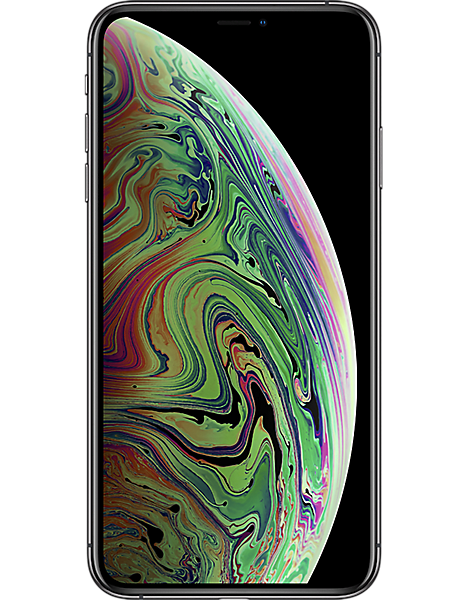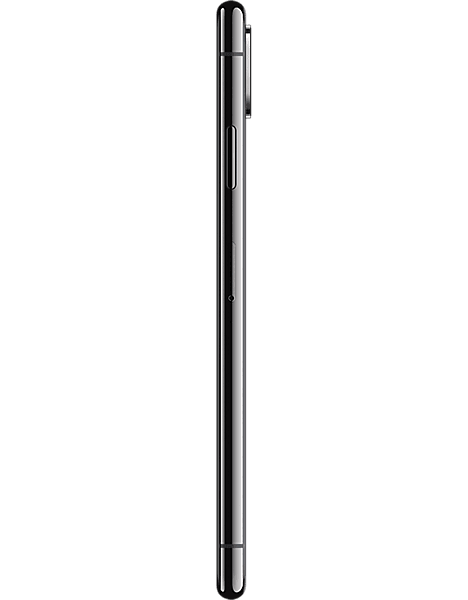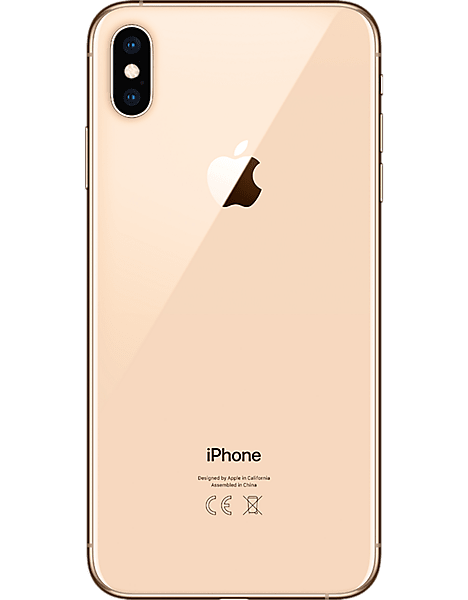
The iPhone XS Max is a plus-sized version of the iPhone XS flagship, sold from September 2018 to 2019. There’s no difference between the two phones other than their physical size, screen size and battery life.
This phone showcases a 6.5” OLED screen that was the biggest ever fitted to an iPhone at the time – even the iPhone 13 Pro Max is only slightly bigger, at 6.7”. It’s a beautiful screen, but the specification elsewhere is a little less exciting. In particular, this phone’s camera is a disappointment next to the best of today’s phones. So is it a sensible refurbished buy? Find out in our iPhone XS Max review.
Pros
- Brilliant design
- Good performance
- Lovely screen
Cons
- Three generations old
- Basic camera
Quick links:
iPhone XS Max – overview
The iPhone XS Max marked the first use of ‘Max’ to describe Apple’s bigger phones. Previously, it had been ‘Pro’. The change in branding reflected the major change to iPhone design from the iPhone X onwards. Previous Plus-sized phones had a 5.5” LCD screen with fat borders above and below. The iPhone XS Max blew them all away, with a 6.5” OLED that stretched to the edges of the phone and packed in more than 60% more pixels.
Other than bigger dimensions and a bigger battery, the iPhone XS Max was identical to the iPhone XS. That was excellent news in 2019, but it’s perhaps not so good now – the phone’s A12 Bionic chip is three generations behind the latest, and its camera system looks particularly weak by today’s standards.
Compared to the iPhone 11 Pro Max, iPhone 12 Pro Max or iPhone 13 Pro Max, the iPhone XS Max is showing its age. But compare prices and it looks like a bargain. While Apple will happily charge you more than a grand for its latest big phone, you can buy a reconditioned iPhone XS Max for less than £300. So is it worth it? Find out in our iPhone XS Max review.

iPhone XS Max – design
You don’t have to be into big phones to appreciate the iPhone XS Max. Compare it to earlier plus-sized iPhones and it’s a stunning step forward, moving iPhone design on just as dramatically and successfully as the iPhone X did for the regular-sized devices. Gone are the huge borders above and below the screen – and with them the TouchID sensor. Instead, there’s a huge, glossy OLED screen stretching away to every edge, and an enhanced FaceID camera for security.
This phone’s sides are curved, smooth stainless steel, and its rear panel is glass. Unlike newer Pro Max models, this is polished rather than frosted, but it still looks classy. The camera mound is far smaller than on newer phones – especially compared with the huge weaponry of the iPhone 13 Pro Max. The overall result is a stunning phone that’s comfortable to hold, but not ideal for one-handed typing.



iPhone XS Max – display

The iPhone XS’ display was one of the key features that set it apart from any other iPhone. At the time of its launch it was the largest yet found on the series – fully an inch bigger than the iPhone 8 Plus, and with about 60% more pixels. But while it was amazing at the time, newer iPhone Pro Max models have a 6.7” display – it’s no longer the unique feature it was.
Like the iPhone XS, this phone’s OLED technology means it provides a bright, sharp, dynamic and crisp picture. It’s perfect for gaming or other media, although it’s a shame that the characteristic ‘notch’ housing the front-facing camera takes a bite out of the edge of the frame. Even so, several years after its launch this remains a great screen for anyone who wants more space for films and other media.
iPhone XS Max – camera and video performance
While the iPhone XS Max is ageing surprisingly well, its camera is a major letdown. Although it’s a dual-lens, 12-megapixel (MP) system, it’s comfortably outclassed by today’s phones. One of the main issues is comparatively poor low-light performance. While the latest iPhones can conjure up images in near-darkness, the iPhone XS Max struggles to make anything much out of the gloom.
It’s perhaps not surprising. Apple gave the iPhone 11 Pro Max a major camera upgrade, then made a similar step forward with the iPhone 13 Pro Max. Newer iPhones have bigger lenses and sensors to capture more light, and use software enhancements to create spectacular images in Night mode. The iPhone 11 Pro Max also introduced the third, telephoto lens found on all Pro branded iPhones. The iPhone XS Max misses out on all of that.
You can work around the comparatively small zoom by getting closer to your subject – or using digital zoom if you don’t mind the loss of detail that comes with it. Unfortunately there’s nothing you can do to improve the disappointing low-light performance. With no Night Mode, this phone can’t resolve images in very low light. It’s fine for everyday portraits, holiday snaps and the like, but if you want a top quality camera, you’ll need something newer.
iPhone XS Max – performance
Geekbench 5 results
CPU single-core scores:
- iPhone 13 Pro – Score= 1,746
- iPhone 11 – Score = 1,334
- iPhone XS Max – Score = 1,120
CPU multi-core scores:
- iPhone 13 Pro – Score= 4,899
- iPhone 11 – Score = 3,442
- iPhone XS Max – Score = 2,799
3DMark Wild Life Extreme results
Best scores:
- iPhone 13 Pro – Score= 3,118
- iPhone 11 – Score = 2,141
- iPhone XS Max – Score = 1,579
Worst scores (20-minute loop):
- iPhone 13 Pro – Score= 2,235
- iPhone 11 – Score = 1,442
- iPhone XS Max – Score = 920
Newer iPhones also have the iPhone XS Max beaten for performance, but that’s not so true for the latest Android phones. Apple continues to dominate in benchmarks, and it’s taken the competition three years to catch up with this phone’s 3D benchmarking scores – most relevant for gaming and intensive media work.
In the 3DMark Wild Life Extreme benchmark, the iPhone XS Max notched up 1,579 – about half what you’d get from an iPhone 13 Pro Max, but only a little short of the 1,800 you might expect from a Samsung Galaxy S21 5G. That said, like other iPhones this phone generates a lot of heat, and after a time it needs to slow itself down to prevent overheating. After 20 minutes, its final score on Wild Life Extreme was just 920 – a fall of more than 40%.
We used Geekbench 5 to measure the A12 Bionic processor’s number-crunching grunt. Its single-core score of 1,120 is just about the maximum you’d get from today’s fastest Android phones. Its multi-core score is far less impressive, though: at 2,799, plenty of high-end Android phones can keep up.
While no longer dominant, there’s no doubt this phone still has plenty of power to run today’s apps and games. While its heat management means it can’t sustain its headline performance figures, it’s still plenty quick enough for most purposes.
iPhone XS Max – battery performance
With a bigger screen, this phone needs a bigger battery to match the endurance of the smaller iPhone XS. Fortunately, its bigger body provides the room. When new, Apple claimed the iPhone XS Max could playback video for up to 15 hours, compared to 14 hours for the iPhone XS. In our test it managed just under 11 hours – only about 20 minutes more than the smaller phone.
While that’s not brilliant, it’s an unrealistic test that forces the energy-hungry phone screen to stay on. In normal use, there’s plenty of juice for a normal day’s use, even if that includes a bit of gaming or video calling.
Apple says that, like most iPhones, the XS Max will charge to 50% within 30 minutes on a 20W charger. We timed 31 minutes – close enough. It needed an hour to hit 80%, and ticked up to a full charge in just under two hours. You can also charge this phone on a Qi wireless pad. While it’s a bit big, it still fitted the wireless dock on a modern car.
Battery life (movie playback)*
- iPhone 13 Pro – Time = 19hr 2mins
- iPhone 11 – Time = 14hrs 45mins
- iPhone XS Max – Time = 10hrs 54mins
Charge Time (0-80%)
- iPhone 13 Pro – Time = 53mins
- iPhone 11 – Time = 55mins
- iPhone XS Max – Time = 52mins
*Battery life test involves looping the playback of an HD movie from fully charged until the phone shuts down.
iPhone XS Max – options and additional features
You could snap up a new iPhone XS Max in just three XS-only colours: gold, silver and Space Grey. While the base model had only 64GB, you could upgrade to 256GB or 512GB – a first for iPhones. There weren’t any other options, but as with any iPhone you can find hundreds of official and third-party accessories to make an iPhone XS Max your own.



iPhone XS Max – build quality and things to look out for
This phone is every bit as well made as you’d expect for an iPhone, but it did suffer some issues at launch. Many users reported WiFi and Bluetooth connectivity problems, while others noted that some portrait photos seemed excessively smoothed, as though airbrushed. Others couldn’t charge without turning on the screen and unlocking the phone.
Fortunately, all these issues were addressed with software updates – any iPhone XS Max running iOS 12.1 or later should work excellently. However, it’s worth remembering that the oldest examples are now three years old, and that their batteries are starting to age. Like other iPhones, you can check the remaining capacity by opening the Settings app, tapping Battery and Battery Health. On well-used models this is likely to be less than 100%.
iPhone XS Max – verdict
There’s no two ways around it – this is far from the latest phone. While it still looks great and works well for most everyday purposes, its performance is beginning to fall behind and its camera is disappointing. If you want a powerful phone for challenging games or creative media projects, you’re going to need something newer.
On the other hand, if you’ve got a limited budget and you fancy combining iPhone design with a lovely big screen, the iPhone XS Max still has lots to offer. With prices starting below £300, it’s by far the cheapest way to get a plus-sized iPhone that’s worth having. Provided you don’t expect too much, a refurbished iPhone XS Max could be a great everyday iPhone – particularly if you want to watch movies or TV on the move.
